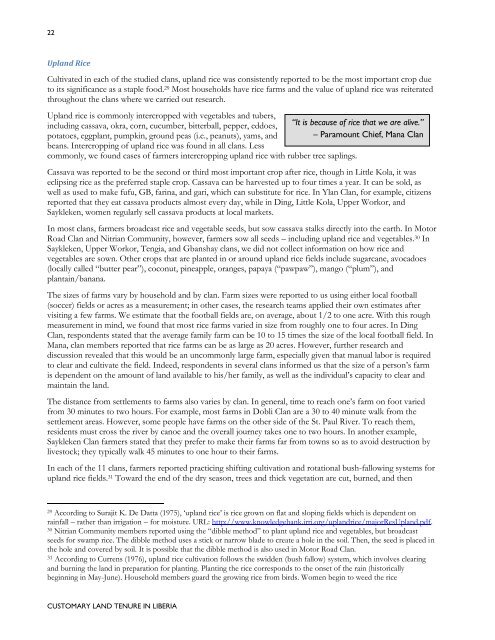Customary Land Tenure in Liberia - Land Tenure and Property ...
Customary Land Tenure in Liberia - Land Tenure and Property ...
Customary Land Tenure in Liberia - Land Tenure and Property ...
Create successful ePaper yourself
Turn your PDF publications into a flip-book with our unique Google optimized e-Paper software.
22<br />
Upl<strong>and</strong> Rice<br />
Cultivated <strong>in</strong> each of the studied clans, upl<strong>and</strong> rice was consistently reported to be the most important crop due<br />
to its significance as a staple food. 29 Most households have rice farms <strong>and</strong> the value of upl<strong>and</strong> rice was reiterated<br />
throughout the clans where we carried out research.<br />
Upl<strong>and</strong> rice is commonly <strong>in</strong>tercropped with vegetables <strong>and</strong> tubers,<br />
<strong>in</strong>clud<strong>in</strong>g cassava, okra, corn, cucumber, bitterball, pepper, eddoes, “It is because of rice that we are alive.”<br />
potatoes, eggplant, pumpk<strong>in</strong>, ground peas (i.e., peanuts), yams, <strong>and</strong> – Paramount Chief, Mana Clan<br />
beans. Intercropp<strong>in</strong>g of upl<strong>and</strong> rice was found <strong>in</strong> all clans. Less<br />
commonly, we found cases of farmers <strong>in</strong>tercropp<strong>in</strong>g upl<strong>and</strong> rice with rubber tree sapl<strong>in</strong>gs.<br />
Cassava was reported to be the second or third most important crop after rice, though <strong>in</strong> Little Kola, it was<br />
eclips<strong>in</strong>g rice as the preferred staple crop. Cassava can be harvested up to four times a year. It can be sold, as<br />
well as used to make fufu, GB, far<strong>in</strong>a, <strong>and</strong> gari, which can substitute for rice. In Ylan Clan, for example, citizens<br />
reported that they eat cassava products almost every day, while <strong>in</strong> D<strong>in</strong>g, Little Kola, Upper Workor, <strong>and</strong><br />
Saykleken, women regularly sell cassava products at local markets.<br />
In most clans, farmers broadcast rice <strong>and</strong> vegetable seeds, but sow cassava stalks directly <strong>in</strong>to the earth. In Motor<br />
Road Clan <strong>and</strong> Nitrian Community, however, farmers sow all seeds – <strong>in</strong>clud<strong>in</strong>g upl<strong>and</strong> rice <strong>and</strong> vegetables. 30 In<br />
Saykleken, Upper Workor, Tengia, <strong>and</strong> Gbanshay clans, we did not collect <strong>in</strong>formation on how rice <strong>and</strong><br />
vegetables are sown. Other crops that are planted <strong>in</strong> or around upl<strong>and</strong> rice fields <strong>in</strong>clude sugarcane, avocadoes<br />
(locally called “butter pear”), coconut, p<strong>in</strong>eapple, oranges, papaya (“pawpaw”), mango (“plum”), <strong>and</strong><br />
planta<strong>in</strong>/banana.<br />
The sizes of farms vary by household <strong>and</strong> by clan. Farm sizes were reported to us us<strong>in</strong>g either local football<br />
(soccer) fields or acres as a measurement; <strong>in</strong> other cases, the research teams applied their own estimates after<br />
visit<strong>in</strong>g a few farms. We estimate that the football fields are, on average, about 1/2 to one acre. With this rough<br />
measurement <strong>in</strong> m<strong>in</strong>d, we found that most rice farms varied <strong>in</strong> size from roughly one to four acres. In D<strong>in</strong>g<br />
Clan, respondents stated that the average family farm can be 10 to 15 times the size of the local football field. In<br />
Mana, clan members reported that rice farms can be as large as 20 acres. However, further research <strong>and</strong><br />
discussion revealed that this would be an uncommonly large farm, especially given that manual labor is required<br />
to clear <strong>and</strong> cultivate the field. Indeed, respondents <strong>in</strong> several clans <strong>in</strong>formed us that the size of a person‟s farm<br />
is dependent on the amount of l<strong>and</strong> available to his/her family, as well as the <strong>in</strong>dividual‟s capacity to clear <strong>and</strong><br />
ma<strong>in</strong>ta<strong>in</strong> the l<strong>and</strong>.<br />
The distance from settlements to farms also varies by clan. In general, time to reach one‟s farm on foot varied<br />
from 30 m<strong>in</strong>utes to two hours. For example, most farms <strong>in</strong> Dobli Clan are a 30 to 40 m<strong>in</strong>ute walk from the<br />
settlement areas. However, some people have farms on the other side of the St. Paul River. To reach them,<br />
residents must cross the river by canoe <strong>and</strong> the overall journey takes one to two hours. In another example,<br />
Saykleken Clan farmers stated that they prefer to make their farms far from towns so as to avoid destruction by<br />
livestock; they typically walk 45 m<strong>in</strong>utes to one hour to their farms.<br />
In each of the 11 clans, farmers reported practic<strong>in</strong>g shift<strong>in</strong>g cultivation <strong>and</strong> rotational bush-fallow<strong>in</strong>g systems for<br />
upl<strong>and</strong> rice fields. 31 Toward the end of the dry season, trees <strong>and</strong> thick vegetation are cut, burned, <strong>and</strong> then<br />
29 Accord<strong>in</strong>g to Surajit K. De Datta (1975), „upl<strong>and</strong> rice‟ is rice grown on flat <strong>and</strong> slop<strong>in</strong>g fields which is dependent on<br />
ra<strong>in</strong>fall – rather than irrigation – for moisture. URL: http://www.knowledgebank.irri.org/upl<strong>and</strong>rice/majorResUpl<strong>and</strong>.pdf.<br />
30 Nitrian Community members reported us<strong>in</strong>g the “dibble method” to plant upl<strong>and</strong> rice <strong>and</strong> vegetables, but broadcast<br />
seeds for swamp rice. The dibble method uses a stick or narrow blade to create a hole <strong>in</strong> the soil. Then, the seed is placed <strong>in</strong><br />
the hole <strong>and</strong> covered by soil. It is possible that the dibble method is also used <strong>in</strong> Motor Road Clan.<br />
31 Accord<strong>in</strong>g to Currens (1976), upl<strong>and</strong> rice cultivation follows the swidden (bush fallow) system, which <strong>in</strong>volves clear<strong>in</strong>g<br />
<strong>and</strong> burn<strong>in</strong>g the l<strong>and</strong> <strong>in</strong> preparation for plant<strong>in</strong>g. Plant<strong>in</strong>g the rice corresponds to the onset of the ra<strong>in</strong> (historically<br />
beg<strong>in</strong>n<strong>in</strong>g <strong>in</strong> May-June). Household members guard the grow<strong>in</strong>g rice from birds. Women beg<strong>in</strong> to weed the rice<br />
CUSTOMARY LAND TENURE IN LIBERIA

















